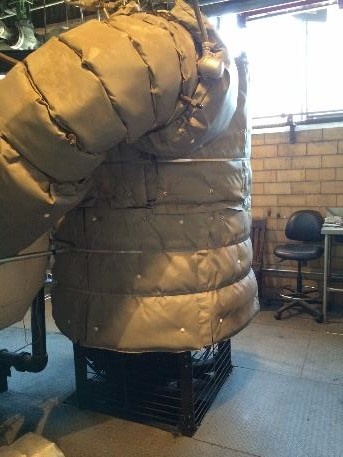
The research of Albert Ratner, University of Iowa Associate Professor of Mechanical and Industrial Engineering, could present a better solution. Ratner and his team have received an 18-month, $125,000 grant from the U.S. Poultry Council to explore disposal of the chickens—and elimination of any residual virus—by use of a gasifier.
The gasifier, located at the UI Research Park, was purchased with a larger energy grant in 2010. Gasifiers run on waste materials, such as leftover seed corn, soybeans, or wood chips, and convert the biomass into biochar, a substance much like charcoal, and syngas, a synthetic version of natural gas containing more carbon monoxide and hydrogen and less methane. The synthetic gas can then be burned for energy or safely flared off.
“The idea we came up with is to use the gasification process to assist in disposing of the chickens, both for existing ones and in the future, so if you have an outbreak of avian flu, you could address it quickly,” Ratner said. “You could hopefully bring units out to sterilize and get rid of the virus.”
The grant begins in July and the research project has several components. First, the chickens will need to be dried. Then they need to be heated up enough that the virus is disabled.
“The virus gets deactivated at about 160 degrees, but you need to get that temperature inside the bones even,” Ratner said. “That’s the difficult part—which is why you have to first dry the chicken, do some chopping, probably some more drying, and then a final bake where you get all the pieces at a high enough temperature.”
Ratner said he has not seen anyone else doing anything similar, but it’s an ideal solution, especially in comparison to technologies such as incineration.
“You could obviously incinerate them,” Ratner said. “The problem is that tends to be very expensive, because incineration requires you to fire with natural gas and then burn the chickens down to ash. That takes a lot of natural gas.”
Waste biomass is available in abundance, making the gasifier a more environmentally friendly solution at a much lower cost.
Ratner is working with two Iowa companies, Independence Energy Company of Des Moines and Ag Bio Power of Tama, on the project. Ag Bio Power originally patented the gasifier technology, and Independence Energy Company has been negotiating a license to commercialize it for wider use. He said it’s conceivable mobile gasifier units could be used by the Federal Emergency Management Agency (FEMA) and the United States Department of Agriculture (USDA), so whenever an outbreak occurs, the gasifiers are quickly deployed to the site to dispose of contaminated materials.
Gasifiers could also be used for trash burning by companies or municipalities that generate large amounts of waste material.
“That’s the hope—that as we get more of the scientific kinks worked out, it could be commercialized to all these different folks,” Ratner said.
Ratner started researching biomass working with the University of Iowa Power Plant in 2005, and many of his research findings regarding potential fuels, as well as pollution control, have been implemented.
“We’ve had a lot of projects with the University Power Plant to enable their boilers to use more biomass,” Ratner said. “We’ve been able to give good insights into how it could be done and how it could be done efficiently and effectively, so I think that’s a real win for the university.”